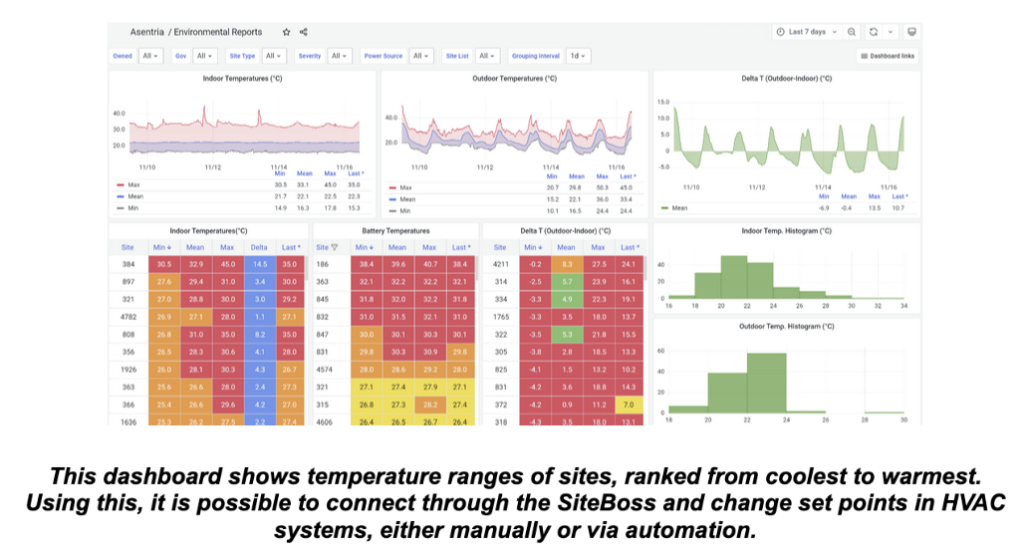
Asentria’s first market solution, which it still offers, is contact closure management. It converts older contact closure alarms schemes to more future-proof and modern methods. For instance, when customers are connecting their contact closure alarming to radio vendor equipment, and don’t want to upgrade their alarm management system each time they convert to the newest radio technology.
Asentria’s most recognizable product is the SiteBoss, which is a mature IoT device that monitors telecom or tower sites. Most often, Asentria is called upon to manage power, security, or environmental systems.
Asentria In Action
Uniti Fiber, a fiber company based in the southeastern United States, is using SiteBoss to monitor a wide range of critical equipment including generators, generator ATS, UPS, HVAC, IP cameras and environmental systems, at remote sites. The SiteBoss is connected to all the underlying power, security, and environmental systems at Uniti’s sites, providing a complete picture of each site’s power — prior to, during, and after weather-related events, giving operations personnel a real-time understanding of the health of their sites.
“The normalized data provided by SiteBoss has high value by itself. Open data formats and protocols are the way forward-looking networks will be monitored,” said Jon Baars, Asentria, Director Sales and Marketing. “Uniti had the good idea to represent the SiteBoss units on ESRI’s geographic information system (GIS) mapping software that shows weather related data. Our SiteBoss units have an open API that includes standard GIS support so that Uniti’s operational staff can see exactly how different weather events are affecting the remote sites in their network on a single screen.”
Towerco in the Middle East
Working with a large towerco in the Middle East, Asentria was able to gather large sets of data from a network of tower sites that had several makes and models of generators, fuel tanks, transfer switches, rectifiers, and HVAC systems. Again, SiteBoss normalized data from different vendors, which allowed the towerco to manage day-to-day troubleshooting of individual site failures and performance, while preparing for mass outage events. The solution also used Asentria Site Manager (ASM) software to help manage large networks of SiteBoss units.
“Using the data created from the site level, we were able to create network-wide dashboards to facilitate the day-to-day operations of the network,” Baars said. “These dashboards illustrate the value in gathering telemetry data from individual sites on power, security, and environmental factors at sites, and how doing so changes the way the networks are managed.”
One network-wide dashboard that was created monitored the towerco’s service level agreement (SLA) compliance for the provision of power. By measuring the presence or absence of AC main power, as well as diesel back-up power and batteries, the Asentria solution calculates how long a site will have power to remain operational.
“This is a useful tool to help operational staff know which sites to prioritize for corrective action,” Baars said. “This proves again the usefulness of the underlying data generated by the SiteBoss units, as this SLA compliance dashboard and associated data also provides a historical record that is in the towerco’s possession to compare with any claimed lack of compliance with the SLA.”
Another dashboard was created to measure greenhouse gas (GHG) emissions based on measured data from network sites. By combining measured power usage — either from grid emissions, diesel generators, or hybrid power sources — the amount of power usage can be matched to sources of electricity generation. This can provide a more accurate picture of the actual GHG emissions from large numbers of tower sites.
“GHG or power-usage dashboards provide direct feedback from power improvements that are made on the network,” Baars said. “These improvements could be steps like switching sites to hybrid forms of power or could be simpler day-to-day improvements made possible by other data the SiteBoss units are providing.”
“Eliminating over-cooled sites is a simple way to save energy and will be directly reflected by reduced power costs and GHG emissions,” Baars said.
It is an old adage that knowledge is power. The same holds true for monitoring tower sites. The more you know about remote assets, the better you can manage power usage and GHG emissions. Asentria provides customized dashboards that allow users to fine tune any number of tower sites over any geographic area to save money on power, meet an SLA or, aid in environmental efforts.
To find out how Asentria can capture and normalize data generated by your telecom sites to better manage them, contact Jon Baars, Asentria Director of Sales & Marketing, via email at [email protected] or visit www.asentria.com.
By J. Sharpe Smith, Inside Towers Technology Editor






Reader Interactions